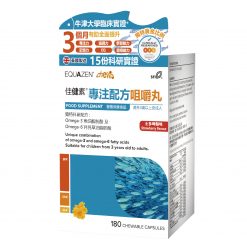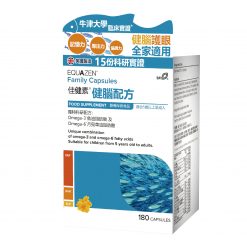必需脂肪酸对身体健康很重要。 * 由于您的身体无法产生其中一些必需脂肪酸,因此必须通过饮食来获取。
Equazen佳健素多年的科学投资已应用于开发和创造Equazen佳健素今天的各类产品。 Equazen佳健素系列混合了不同比例的 Omega-3 和 Omega-6,针对不同的阶段提供相应的鱼油产品。 *
为什么脂肪和脂肪酸很重要?
膳食脂肪是我们日常饮食的一部分。它们属于更大的一组称为脂质的化合物。脂质有助于构建我们的细胞膜,对我们的中枢神经系统至关重要——约占大脑重量的 50-60%! 5
在这些脑脂质中,大约 35% 由多不饱和脂肪酸 (PUFAs) 组成,其中包括 Omega-3 和 Omega-6 脂肪酸。必需脂肪酸 (EFA) 是 PUFAs 的一种,它不能由您的身体制造或储存,必须通过食物或补充剂吸收。

为什么脂肪很重要?
脂肪在我们的身体中起着至关重要的作用。它们储存能量,是我们细胞膜的重要组成部分,为组织提供隔离作用,缓冲我们的许多器官,并在我们的血液中携带维生素。此外,它们对于帮助我们从饮食中获取所需的其他营养素很重要。更不用说它们对烹饪非常有用,可以增加很多风味,并改善我们食物的质地。 1
有些人可能对脂肪有一些担忧,这主要源于脂肪与体重增加的联系。脂肪因其能量储存的能力而导致我们体重增加。当您将脂肪与蛋白质和碳水化合物进行比较时,脂肪储存的能量比蛋白质和碳水化合物的能量要多两倍。 2
1 克脂肪 = 9 卡路里
1 克碳水化合物或蛋白质 = 4 卡路里

那脂肪酸呢?
脂肪是由甘油和脂肪酸组成的,当脂肪被分解时便产生脂肪酸。
不同类型的脂肪由许多不同类型的脂肪酸制成,它们在我们体内有许多不同作用。了解有关脂肪酸类型的更多信息。
**儿童的正常生长发育需要必需脂肪酸(ALA)和(LA)。每天摄入 2 克 α 亚麻酸 (ALA) 和 10 克亚油酸 (LA) 可获得有益效果。

DHA和EPA属于奥米加-3多不饱和脂肪酸,而GLA则属于结构中特殊的奥米加-6必需脂肪酸。人体不能自行合成EPA、DHA和GLA,因此必须从食物或营养补充剂中吸收。
EPA
EPA 奥米加-3 功能性不饱和脂肪酸 ( 二十碳五烯酸 )
- EPA有助脑细胞沟通, 增强神经讯息传递
- 提高协调力, 专注力, 控制情绪
- 助DHA更稳健地维持在细胞结构
- 心血管更富弹性, 减低坏血脂
DHA
DHA 奥米加-3 结构性不饱和脂肪酸 ( 二十二碳六烯酸 )
- DHA是脑细胞及视网膜主要的组织成份。对脑部初期发展 (0-3岁) 极为重要(*此表没列出所有功能)
研究显示,在合适比例的不同脂肪酸的相互作用下,脑细胞的讯息接收能力倍增,所产生的效益远比个别成份更为显著。佳健素除含有优质鱼油外,更含有天然有机的月见草油(GLA),佳健素成份独特,有助全面的补充及吸收。

GLA
GLA 奥米加-6 ( γ次亚麻油酸 )
- GLA有助减少脑部破坏性发炎因子产生,保护脑细胞
- 帮助提升EPA效能
- 平衡脂肪酸比例


 English
English 中文 (香港)
中文 (香港)


